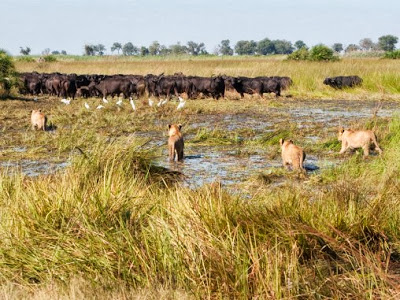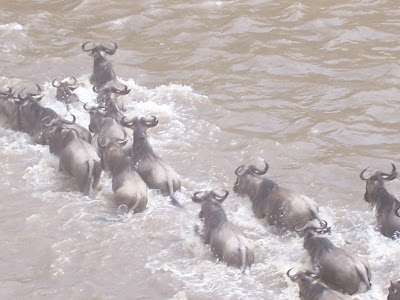The morning
sight that greeted us at Lake Nakuru, took my breath away! This couldn't be
Africa!
What a world of contrast from the arid dusty browns of the Masai Mara.
This was a world of soft, cold, wintry day, with smoke coming out of our breath,
the splendour of the mist and the greens, the birds and the rare rhino’s I had
yet to know and meet… the magic waiting to unfold.
The quiet
and the calm of the early morning light was delightful. For now, finding the
next animal was a secondary issue – being out in the crisp air, filling my
lungs with pristine oxygen was a high, indescribable; I was trigger happy
discovering such picture postcard perfect snaps created by Nature, ready to
help me show off, when I returned home :D
A band of
dark clouds were creeping up in the western sky as we moved through the park
towards the flamingo point to take advantage of the light while it was still
present. We were a little disappointed with the ‘not so many flamingos” we
spotted.
The safari agents were not upfront honest, nor did we do enough
homework ourselves to realize about the flamingos going elsewhere as a result
of heavy rainfall and lack of salinity in the lake.
Sam drove us quickly through the slushy tracks onto the other side of the lake to a dotted
shoreline of pink fuchsia flamingos gracefully taking in the early worm. On the
water drenched track side, their more distant cousins the African White
Pelicans played happily in the wet lands! :D
Sam informed
us that the reason the flamingos appear to be standing in a line is because they
are perched on a sandbar, eating rows of algae. As the lake begins to dry, the bird
droppings stick around longer, creating more algae on sandbar, all along the
edges of the shore. The more the algae, the more food there is, and therefore the
more flamingos that are drawn in. The best time to visit this national park is in
the height of the dry season if you want to see the million flamingo phenomenon.
Besides the pink-rimmed
shoreline of Lake Nakuru we spotted a variety of other birds and animals
– a flock
of yellow-billed Storks, the rare White Rhino, the Olive Baboons, Colombus monkey, the common Zebras grazing by the track side,
close enough for me to take a picture of their gorgeous designer booty!:D
And more wildlife -the Yellow-billed
ducks , Egyptian Geese, Dik diks, Hadada Ibis, Red-billed Teal, the Waterbuck, a Malachite Kingfisher, more African White
Pelicans, the water bucks…
Lake Nakuru,
is the only fenced park in all of Kenya. It’s not fenced to keep the wildlife
in, but to keep the poachers out. Poaching is a very real problem for the
rhinos in Kenya who are abundant today, but were most vulnerable and near
extinct, till a few years ago.
These giant
rhinos are slow to reproduce and have a built in defence mechanism to not have
babies if it feels the environment is unsafe. For decades the wildlife of
Africa has been decimated by hunters, so for decades, rhinos rarely reproduced.
The Lake Nakuru project is so successful that rhinos are having babies and as
their population grows, they’ve been transferred and donated to 23 other parks
to help rebuild the rhino numbers in Africa. It’s an uplifting story and to
watch these magnificent creatures, I cannot understand how people can kill them
simply for the fibres on their horns. Such a waste
It was a
quick transition leaving the lake park, heading into the city – one minute we were surrounded by the mist, cold air, animals, birds, the lush greenery of the highlands, then a short while later, we were zipping on a smooth tarred runaway with the street lights, the only reminder, for where we had been.



















































